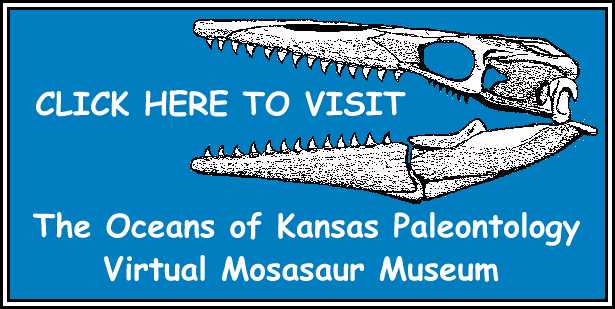Oceans of Kansas Paleontology (original) (raw)
You can now download a copy of this early article on Kansas Sharks by Williston - Provided by the Kansas Geological Survey.
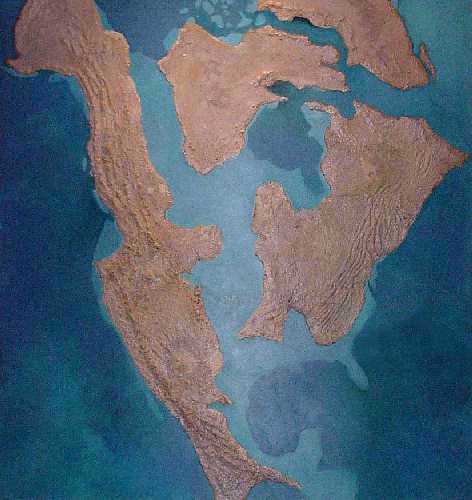 |
The Cretaceous Period lasted from about 144 million years ago to 65 million years ago. In Kansas, it is represented by marine and estuarine deposits from the Early Cretaceous (Albian) Cheyenne Sandstone and Kiowa Shale that overlay the Wellington Formation (Permian) or the Morrison Formation (Jurassic) at the base, to the Pierre Shale at the top. (See Kansas Geology Map and Time Scale).A brief Cretaceous Time Scale is found here. The 1999 version of the GSA (Geological Society of America) geologic time scale is found HERE as a printable .pdf file (233 kb). A major part of the upper portion (Late Cretaceous) of these deposits is referred to as the Niobrara Formation. It contains a rather unique member called the Smoky Hill Chalk, and provides the exposures for two Kansas landmarks: Castle Rock and Monument Rocks. The chalk found in Kansas was deposited between 87 and 82 million years ago during a period when a shallow inland sea (the Western Interior Sea) covered most of the Midwest from the Gulf of Mexico to the Arctic Circle. The deposition of these chalky, marine sediments occurred during the last half of the Cretaceous Period, approximately 15-20 million years before the end of the Age of Dinosaurs. The Smoky Hill Chalk member is about 600 feet thick in Kansas, and lies conformably above the Fort Hays Limestone, and below the Pierre Shale. For the most part, the chalk is composed of the compacted shells (coccolithophores) and plates (coccoliths) of an abundant, microscopic, golden-brown algae (Chrysophyceae) that lived in the clear waters of a warm, shallow sea. A large percentage of the chalk is made up of coprolites containing coccoliths from the animals that fed on the algae. |
|---|
A generalized map of the North American continent during late Cretaceous time. The Western Interior Sea covered most of the Midwest from the present Gulf of Mexico to the Arctic. (Map modified from an exhibit at the University of Nebraska State Museum)
The Western Interior Sea, sometimes called the Inland Sea, was probably less than 600 feet deep in most areas, and had a relatively flat and soft, mud bottom. It is considered to be an 'epi-continental sea'; that is, one which lies on top of a continental landmass, and not between continents. Near the middle of the sea where Kansas is now located, sediments were deposited at a rate which would ultimately produce about one inch of compacted chalk for every 700 years. The chalk also has more than a hundred thin layers of bentonite clay, most of which are rusty red in color, that are the result of the fall of ash from repeated eruptions of volcanoes to the west of Kansas in what is now Nevada and Utah. These ash deposits can be traced for miles across the chalk beds and have been used as marker units in describing the stratigraphy of the formation (See Hattin, 1982). In addition, several species of vertebrate and invertebrate marine life that lived and/or became extinct at certain times during the deposition of the chalk are useful in determining the age and biostratigraphy of widely separated exposures (See Stewart, 1990). Near the end of the Cretaceous, the Western Interior Sea began to close, becoming shallower and narrower as the Rocky Mountains were pushed up from the west, uplifting the sea bottom as they rose. Eventually, the center of North America rose above sea level and the sediments (limestones, sandstones, shales and chalk) deposited on the basement rocks of Kansas for nearly half a billion years began to erode away.
This shallow ocean was home to a variety of marine animals, almost all of which are now extinct. These included giant clams, rudists, crinoids, squid, ammonites, numerous sharks and bony fish,turtles, plesiosaurs, mosasaurs , Pteranodons and even several species of marine (toothed) birds. Although it seems unlikely that you would find dinosaur fossils in the middle of the Western Interior Sea, a number of them (a hadrosaur found by O. C. Marsh in 1871, and several nodosaurs, includingthe type specimen of Niobrarasaurus coleii) have been collected from the Smoky Hill Chalk, and their remains have been well documented. The bodies of these dinosaurs must have somehow floated hundreds of miles into the sea before sinking to the bottom or being torn apart by scavenging sharks. It is possible that they died during catastrophic flooding on the land masses to the east or west, and were carried out to sea on a large, tangled mat of trees and other vegetation (fossilized wood, including large logs, is also known from the chalk).
Over a period of about five million of years, the remains of many of these animals were preserved as fossils in the soft, chalky mud of the sea bottom. When this mud was compressed under thousands of feet overlying shale, it became a deposit of chalk that is more than 600 feet thick in Western Kansas. Most of the massive chalk formation that once covered Kansas, however, has been eroded away over the last 60 million years and is now exposed only in a relatively small area in the northwestern corner of the State. This part of Kansas is also known as the Smoky Hills.
Since 1868 and the discovery of Tylosaurus proriger, the Smoky Hill Chalk has been the source of thousands of fossil specimens, many of which are on exhibit today in museums around the world. The first significant collections of Kansas fossils were made by relatively unknown scientists like Professor Benjamin F. Mudge, Dr. George M. Sternberg, Dr. John Janeway, and Dr. Theophilus H. Turner. Many others were collected by and for such famous paleontologists as Edward Drinker Cope, O. C. Marsh, Samuel W. Williston, and Charles Sternberg, (for more information on the Sternberg family, click here), including a large portion of the Yale Peabody Museum collection that resulted from the Yale College Scientific Expeditions of the 1870s. For some 'old time' advice on collecting fossils, see an 1884 article by Charles H. Sternberg here. Much of the early work on mosasaurs in Kansas was published in The University Geological Survey of Kansas in the late 1890's. A large number have been found since then by amateur collectors and many of these have been significant additions to paleontology. The Sternberg Museum of Natural History at Fort Hays State University, the Museum of Natural History at The University of Kansas, and the University of Nebraska State Museum have excellent collections of fossils from the Smoky Hill Chalk. The Denver Museum of Nature and Science, the Sam Noble Museum of Natural Historyin Norman, Oklahoma, the Field Museum of Natural History in Chicago, the Philadelphia Academy of Natural Sciences, and the American Museum of Natural History also have many Kansas fossils. Click here for additional information about some early American paleontologists. For a free downloadable copy (.pdf file) of Samuel Williston's (1914) excellent book: Water Reptiles of the Past and Present, CLICK HERE.
RECOMMENDED RECENT BOOKS ON PALEONTOLOGY
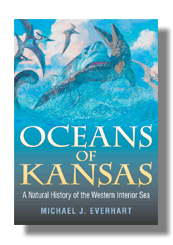 |
Oceans of Kansas is now available as a book. The book describes the animals that lived in the shallow sea covering Kansas during the Late Cretaceous and left their remains as fossils in the Smoky Hill Chalk. "A journey to a time when sea monsters roamed the middle of America" Published by the Indiana University Press, Spring 2005 |  |
|---|
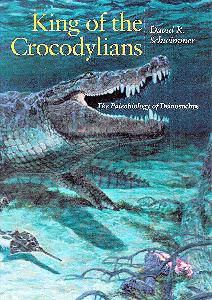 |
King of the Crocodylians The Paleobiology of Deinosuchus David R. Schwimmer Published 2002 by the Indiana University Press, 220 pages |
|---|
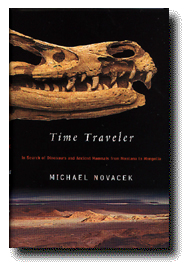 |
Time Traveler In search of dinosaurs and ancient mammals from Montana to Mongolia by Michael Novacek , Curator of Paleontology, American Museum of Natural History Published by Farrar, Straus and Giroux, New York, 2002 See my review in Palaeontologia Electronica (Vol. 5, Issue 1) |
|---|
Click here to go to the: Table of Contents
Click here to go to my: Paleontology Links
Click here for more information: About Mosasaurs
Click here for more information: About Oceans of Kansas Paleontology
 |
May 27, 2003 Oceans of Kansas Paleontology is one of 5 sites given a 2003 SCI-TECH Web Award in the Anthropology and Paleontology category by Scientific American |  |
|---|
